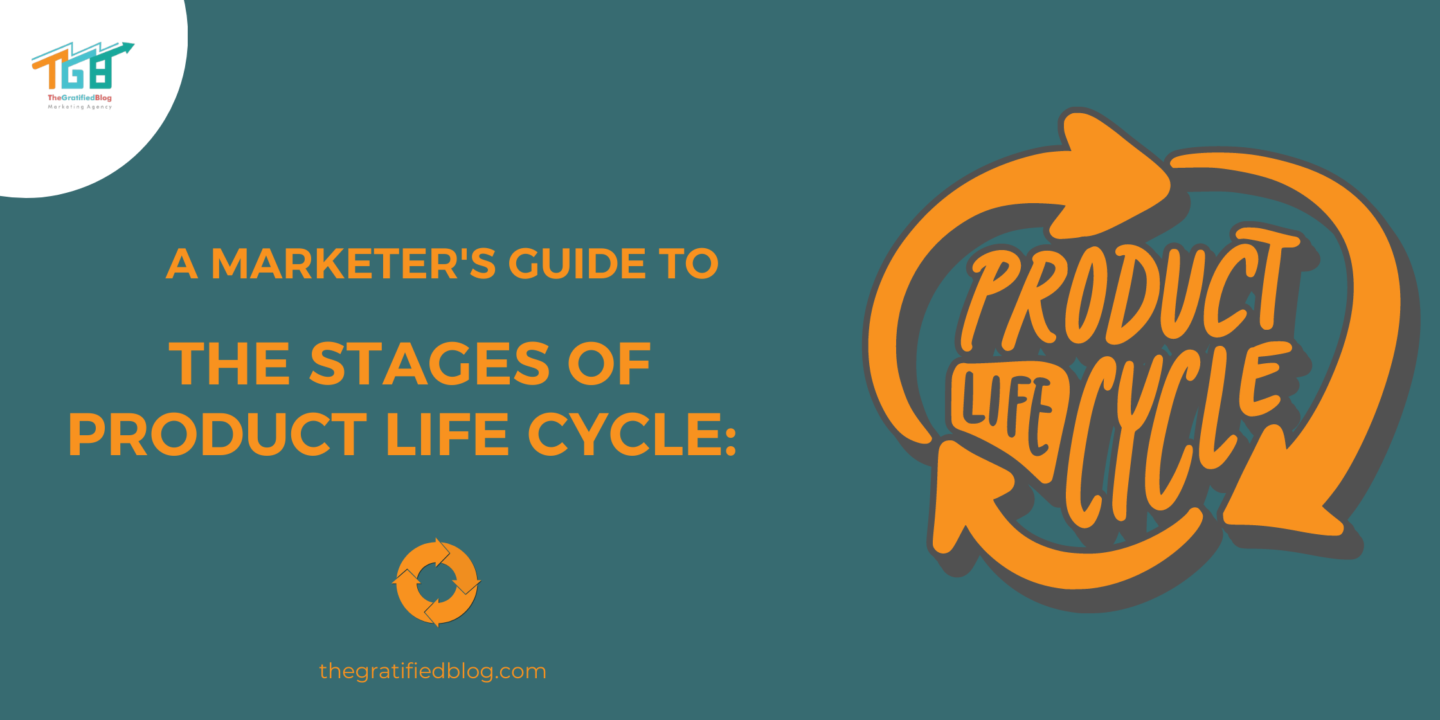
The product life cycle stages are vital components that business owners and marketers must comprehend to manage their products effectively and maximise their profits. Neglecting this crucial concept in marketing can result in missed opportunities to make informed decisions and ensure the long-term success of a product.
In this blog, we will explore the four stages of product life cycle. We will define each stage, discuss its characteristics, and outline the marketing strategies businesses can use to manage their products during that stage. Additionally, we will provide examples of products in each stage to help illustrate the concepts.
By the end of this blog, you will have a comprehensive understanding of the product life cycle and how to manage your products effectively throughout each stage.
So, let’s dive in!
What Is The Product Life Cycle?
The product life cycle is a concept that describes the stages a product goes through, from its introduction to the market until its eventual decline and discontinuation. It is a valuable framework for understanding a product’s dynamics and challenges in the marketplace.
Importance Of Understanding Product Life Cycle Stages
Understanding the product life cycle stages is essential for businesses for several reasons. A few of them are mentioned below:
Developing Effective Marketing Strategies
Each stage of the product life cycle requires different marketing strategies to be effective. By understanding the product’s stage, businesses can develop and implement the appropriate marketing strategies that will help maximise sales and profitability.
Product Development
Understanding the product life cycle can help businesses plan and develop new products or product variations that will meet the changing needs of customers and the market.
It can also help businesses determine when to invest in new product development and when to focus on improving existing products.
Identifying Opportunities
Understanding the product life cycle can help businesses identify new growth and expansion opportunities.
For example, businesses may identify new markets or product variations that can help extend a product’s life or generate new revenue streams.
Managing Costs And Product Exit
The product life cycle can help businesses to manage costs and optimise profitability. During the introduction and growth stages, companies invest heavily in marketing and product development to generate sales and build market share.
However, during the maturity and decline stages, businesses may need to focus on cost-cutting measures to maintain profitability.
Finally, understanding the product life cycle can help businesses decide when to exit a product.
By recognising the signs of decline and understanding the costs and benefits of continuing to invest in a product, businesses can make informed decisions about product exit strategies that minimise losses and optimise profitability.
What Are The Stages Of Product Life Cycle
The product life cycle is composed of four distinct stages.
- Introduction
- Growth
- Maturity, and
- Decline
To successfully manage a product’s life cycle and maximise profits, businesses must understand the unique characteristics of each stage and use different marketing strategies accordingly. Companies must recognise the specific needs of each stage in the product life cycle.
So, let’s dive into each stage and understand it in a better way:
Stage 1: Introduction
The introduction stage of the product life cycle is the initial phase when a new product is introduced to the market. The product is launched and made available to consumers for the first time during this stage. The primary characteristics of the introduction stage include:
- Market Entry: The product is introduced to the market, and customers become aware of its existence. Companies may engage in extensive marketing and promotional activities like gamification marketing to create awareness and generate interest among potential buyers.
- Low Sales: Sales are typically low during this stage as the product is unfamiliar to consumers and may face initial resistance. Customers may hesitate to try something new or require time to understand its benefits and value proposition.
- High Costs: Companies often incur significant costs during the introduction stage. These costs include product development, market research, manufacturing, and initial marketing expenses. Additionally, distribution and promotional costs can be high due to the need for broader market reach and educating consumers about the new product.
- Limited Competition: Since the product is new to the market, there may be limited or no direct competition initially. This allows the company to establish a unique market position and capture early adopters.
- Profitability Challenges: Profit margins are typically low or negative during the introduction stage. High costs and low sales volume can result in limited profitability. Companies often make substantial investments during this stage with the expectation of reaping the rewards in subsequent stages.
- Product Enhancements: Companies may gather feedback from early customers and make improvements or refinements to the product based on initial market response. These enhancements can increase product appeal and address any initial shortcomings or limitations.
- Marketing Focus: The marketing efforts during the introduction stage primarily focus on creating awareness, generating interest, and educating consumers about the product’s features, benefits, and value proposition. Companies may utilise various marketing channels, such as advertising, public relations, digital marketing, and AI marketing, to reach their target audience.
The introduction stage sets the foundation for the product’s life cycle and its subsequent stages. The success of the introduction stage often depends on factors such as effective marketing, product differentiation, and addressing customer needs and preferences.
Stage 2: Growth
The growth stage is the second phase of the product life cycle, following the introduction stage. During this stage, a product experiences a significant increase in sales and market acceptance. Here are the key characteristics of the growth stage:
- Rapid Sales Growth: In the growth stage, sales accelerate as the product gains traction in the market. Customers become more aware of the product and purchase it more significantly. The product captures the attention of a broader customer base, including early adopters and the early majority.
- Increasing Market Share: As sales volume grows, the product’s market share expands. Companies aim to gain a competitive advantage and secure a more significant portion of the market. Increased market share can result from effective marketing, strong product differentiation, and positive word-of-mouth recommendations.
- Profitability Improvement: With the surge in sales volume, the product’s profitability tends to improve. Economies of scale may be achieved, leading to cost efficiencies in production and distribution. Increased sales revenue and improved profit margins contribute to the product’s financial success.
- Competitive Entry: The growth stage attracts the attention of competitors who recognise the product’s market potential. New entrants may introduce similar or alternative products, intensifying competition. Companies must continuously innovate, improve features, or strengthen their marketing efforts to maintain or grow their market share.
- Expanded Distribution: Companies often expand their distribution channels during growth to meet rising demand. This may include securing more retail partnerships, expanding into new geographic regions, or exploring online sales channels. Accessible and widespread distribution helps maximise the product’s reach and availability.
- Product Enhancements: Companies may focus on product enhancements and improvements as the product gains market acceptance. Customer feedback and market research can guide these efforts to refine features, address any limitations, or introduce new variations to cater to different customer segments.
- Increased Marketing Expenditure: While profitability improves during growth, companies invest heavily in marketing and promotion to sustain the momentum and capture a larger market share. Marketing efforts may include advertising campaigns, targeted promotions, public relations, and building brand equity.
The growth stage is an exciting phase for a product, with rising sales, improved profitability, and expanding market presence. Companies must capitalise on this stage by solidifying their position, anticipating competition, and continually meeting customer expectations to prolong the product’s growth trajectory.
Stage 3: Maturity
The maturity stage is the third phase of the product life cycle, following the growth stage. During this stage, a product reaches its peak level of market penetration and experiences a period of stability. Here are the key characteristics of the maturity stage:
- Market Saturation: In the maturity stage, the product has achieved widespread market acceptance, and most potential customers interested in it have already made their purchases. The market becomes saturated, meaning there is limited room for further growth in terms of new customers.
- Slower Sales Growth: The sales growth rate slows significantly during the maturity stage compared to the growth stage. The product’s sales volume reaches a plateau, and the focus shifts from acquiring new customers to retaining existing ones. Companies aim to maintain their market share in the face of intense competition.
- Intense Competition: The maturity stage is characterised by high competition, as multiple companies offer similar products to the same customer base. Price competition becomes more prominent as companies strive to differentiate themselves and attract customers through pricing strategies, product variations, or promotional activities.
- Stable Profitability: Profit margins in maturity tend to stabilise or decline slightly. While the sales volume may still be relatively high, the intense competition and potential price pressure can impact profitability. Companies focus on cost management, operational efficiencies, and maintaining profitability despite market saturation.
- Product Differentiation: Companies may emphasise product differentiation during maturity to sustain market share and compete effectively. This can involve introducing new features, offering improved customer service, or launching variations or extensions of the product to cater to different customer preferences or needs.
- Market Segmentation: Companies may identify and target specific market segments within the overall market during the maturity stage. By tailoring marketing efforts and product variations to particular customer groups, companies can maintain or grow their market share by appealing to different consumer preferences and needs.
- Marketing and Promotion: During the maturity stage, marketing efforts focus on reinforcing brand loyalty, maximising customer retention, and defending market share. Companies may invest in marketing campaigns highlighting product benefits, emphasising value propositions, and building customer loyalty through rewards programs or personalised experiences.
- Cost Efficiency: As market saturation and competition increase, companies strive to optimise costs and improve operational efficiencies during maturity. Streamlining production processes, managing inventory levels, and negotiating better supplier contracts are ways to maintain profitability in the face of market challenges.
The maturity stage is critical for companies to maintain their market position and profitability. Strategies to prolong the maturity stage include product innovation, effective marketing, customer retention efforts, and exploring new market segments or geographic regions. Eventually, as market conditions evolve, the product will enter the decline stage of the life cycle.
Stage 4: Decline
The decline stage is the fourth and final phase of the product life cycle. During this stage, a product experiences a decline in sales and market demand, signalling its diminishing relevance or obsolescence. Here are the key characteristics of the decline stage:
- Decreasing Sales: Product sales decline as consumer demand decreases or shifts towards newer alternatives. Customers may find more appealing or technologically advanced options, leading to a decrease in sales volume.
- Profit Erosion: With declining sales, profit margins tend to erode. As companies need help to maintain market share, they may be forced to lower prices to attract remaining customers, resulting in reduced profitability. High competition and limited demand contribute to the profit decline.
- Market Saturation: The decline stage is often a result of market saturation or a significant change in consumer preferences. Most potential customers interested in the product have already purchased it, and the market becomes saturated with existing users.
- Technological Advances or Substitutes: Technological advancements or the emergence of superior substitute products can render the existing product less desirable or outdated. Customers may shift their preferences towards newer and more innovative options, leading to declining demand for older products.
- Decreased Marketing Support: Companies may reduce their marketing efforts and expenditures as the product enters the decline stage. The focus shifts from growth and market expansion to managing costs and maximising profits from the declining product. Marketing activities may be scaled back, and promotional efforts may be limited.
- Product Rationalization: Companies may discontinue the product during the decline stage if it becomes economically unviable or no longer aligns with their strategic objectives. They may redirect resources to more profitable products or explore alternative revenue streams.
- Niche Targeting: Instead of discontinuation, companies may target niche markets or specific customer segments with unique needs that still find value in the product. Companies can extend the product’s lifespan and extract additional profits by catering to a smaller loyal customer base.
- Cost Management: During the decline stage, companies manage costs to maximise profitability. This may involve reducing production and distribution expenses, negotiating better supplier contracts, or optimising inventory levels.
- Product Harvesting or Divestment: In some cases, companies may gradually reduce investment and support for the declining product, allowing it to phase out naturally. Alternatively, they may decide to divest from the product entirely, selling off assets or discontinuing production.
The decline stage signals the end of a product’s life cycle as sales and demand diminish. While efforts can be made to extend the decline stage, ultimately, the product will face obsolescence or be replaced by newer innovations. During this stage, companies must make strategic decisions regarding cost management, market positioning, and potential exit strategies.
FAQs
What is the Introduction Stage of the Product Life Cycle?
The Introduction Stage is the initial phase when a new product is launched. It’s characterised by low sales, high marketing expenses, and efforts to build consumer awareness.
What are the Characteristics of the Growth Stage?
The Growth Stage is marked by increasing sales, growing market acceptance, and rising competition. Companies focus on expanding market share, improving product features, and maximising profits during this phase.
Final Thoughts
Now that you thoroughly understand the stages of a product life cycle, It’s time to try this cycle on your own and see what results in its drives.
If you still need help understanding the topic, please leave your questions in the comments section. We will be happy to help you.
Thanks for reading 🙂








No Comments